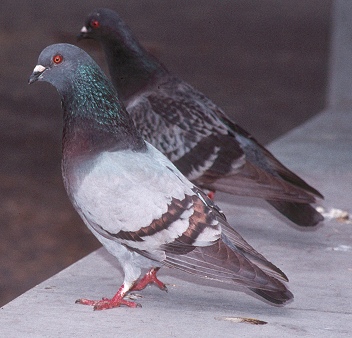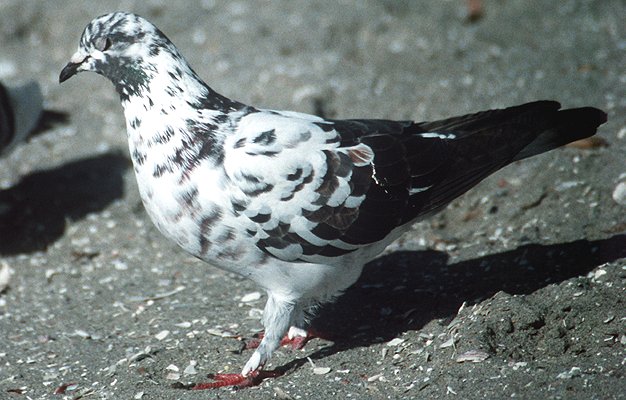|
Rock Pigeon Columba livia Paloma Doméstica
|
 |
|
Photo: M. Oberle
|
|
Rock Pigeon Columba livia Paloma Doméstica
|
 |
|
Photo: M. Oberle
|
|
IDENTIFICATION: The plumage of this bird in its native lands is dark gray with a white rump, and dark banding on the wings and tail tip. The neck has purple iridescence. However, Rock Pigeons whose ancestors have recently escaped from captivity may have a variety of white, brown, gray, black and bluish colors that have been bred over the centuries into captive varieties. Length: 31-34 cm.; weight: 180-355 g. VOICE: A variety of coo-ing notes. Audio (M. Oberle). HABITAT: City parks, buildings, streets, and fields near human habitation. HABITS: Travels in flocks to preferred feeding grounds, and is often quite bold in city parks. The male displays by inflating its neck and strutting in front of the female. Wild Rock Pigeons nest in colonies on or near man-made structures, such as churches, abandoned buildings, and store fronts, where they build a crude nest of sticks and other plant material. The Rock Pigeon mates for life. Although it lays only two eggs at a time, it may have up to five broods a year. Nest material and feces accumulate with each nesting, so that older nests can be 20 cm. high. The female incubates the eggs by night, the male by day. The incubation period is 16-19 days, and the young fledge 35-37 days after hatching. STATUS AND CONSERVATION: Common, introduced species in urban areas. Rock Pigeons are kept by many hobbyists in Puerto Rico, so it may not be clear whether a specific flock is domesticated or wild. The Rock Pigeon was domesticated about 5,000 years ago. It was used as a carrier pigeon to carry messages, and is still kept for food, racing, or show. In the second Iraq War, American troops used Rock Pigeons for early detection of chemical weapons attacks. RANGE: Native to Europe and Asia, but now introduced worldwide in urban areas. Regular inhabitant of many town plazas throughout Puerto Rico. TAXONOMY: COLUMBIFORMES; COLUMBIDAE. Formerly called Rock Dove. |
|
 |
|
|
Photo: G. Beaton
|
 |
|
|
Photo: M. Oberle
|
 |
|
|
Photo: G. Beaton
|
|
References Acholonu, A. D., and M. E. Acholonu. 1973. Avian haematozoa of southwestern Puerto Rico. Prog. Protozool. 4:3. Camacho Rodríguez, M., J. Chabert Llompart, and M. López Flores. 1999. Guía para la identificación de las aves exóticas establecidas en Puerto Rico. Depto. de Recursos Naturales y Ambientales, San Juan, PR. del Hoyo, J., A. Elliott, and J. Sargatal, eds. 1998. Handbook of Birds of the World, Vol. 4. Sandgrouse to cuckoos. Lynx Edicions, Barcelona. Gibbs, D., E. Barnes, and J. Cox. 2001. Pigeons and doves: A guide to the pigeons and doves of the world. Yale University Press. Johnson, K. P., S. de Kort, K. Dinwoodey, A. C. Mateman, C. ten Cate, C. M. Lessells, and D. H. Clayton. 2001. A molecular phylogeny of the dove genera Streptopelia and Columba.. Auk 118(4):874-887. Johnston, R. F. 1992. Rock Dove (Columba livia). No. 13 in The birds of North America (F. Gill, A. Poole, and P. Stettenheim, eds.). Acad. Nat. Sci., Philadelphia, PA, and Am. Ornithol. Union, Washington, D.C. McLauglin, E. T. 1968. Pigeon malaria in San Juan, Puerto Rico. Carib. J. Sci. 8:101-102. Raffaele, H.A. 1989. A guide to the birds of Puerto Rico and the Virgin Islands. Princeton. Raffaele, H.A. 1989. Una guía a las aves de Puerto Rico y las Islas Vírgenes. Publishing Resources, Inc., Santurce, PR. Raffaele, H.A., J.W. Wiley, O.H. Garrido, A.R. Keith, and J.I. Raffaele. 1998. Guide to the birds of the West Indies. Princeton. Next related species in taxonomic order Previous related species in taxonomic order |
|